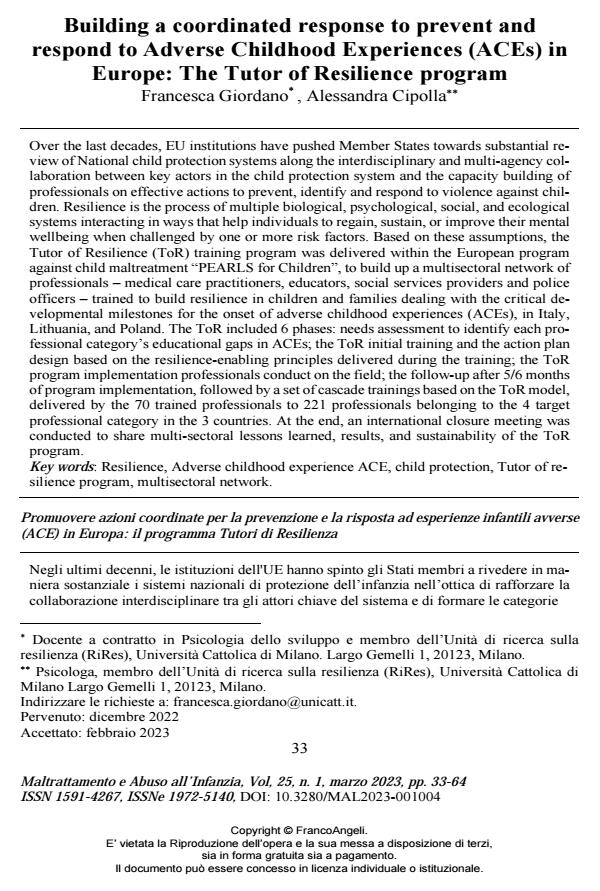Building a coordinated response to prevent and respond to Adverse Childhood Experiences (ACEs) in Europe: The Tutor of Resilience program
Journal title MALTRATTAMENTO E ABUSO ALL’INFANZIA
Author/s Francesca Giordano, Alessandra Cipolla
Publishing Year 2023 Issue 2023/1
Language English Pages 32 P. 33-64 File size 321 KB
DOI 10.3280/MAL2023-001004
DOI is like a bar code for intellectual property: to have more infomation
click here
Below, you can see the article first page
If you want to buy this article in PDF format, you can do it, following the instructions to buy download credits

FrancoAngeli is member of Publishers International Linking Association, Inc (PILA), a not-for-profit association which run the CrossRef service enabling links to and from online scholarly content.
Over the last decades, EU institutions have pushed Member States towards substantial review of National child protection systems along the interdisciplinary and multi-agency collaboration between key actors in the child protection system and the capacity building of professionals on effective actions to prevent, identify and respond to violence against children. Resilience is the process of multiple biological, psychological, social, and ecological systems interacting in ways that help individuals to regain, sustain, or improve their mental wellbeing when challenged by one or more risk factors. Based on these assumptions, the Tutor of Resilience (ToR) training program was delivered within the European program against child maltreatment "PEARLS for Children", to build up a multisectoral network of professionals - medical care practitioners, educators, social services providers and police officers - trained to build resilience in children and families dealing with the critical developmental milestones for the onset of adverse childhood experiences (ACEs), in Italy, Lithuania, and Poland. The ToR included 6 phases: needs assessment to identify each professional category’s educational gaps in ACEs; the ToR initial training and the action plan design based on the resilience-enabling principles delivered during the training; the ToR program implementation professionals conduct on the field; the follow-up after 5/6 months of program implementation, followed by a set of cascade trainings based on the ToR model, delivered by the 70 trained professionals to 221 professionals belonging to the 4 target professional category in the 3 countries. At the end, an international closure meeting was conducted to share multi-sectoral lessons learned, results, and sustainability of the ToR program.
Keywords: Resilience, Adverse childhood experience ACE, child protection, Tutor of resilience program, multisectoral network.
Francesca Giordano, Alessandra Cipolla, Building a coordinated response to prevent and respond to Adverse Childhood Experiences (ACEs) in Europe: The Tutor of Resilience program in "MALTRATTAMENTO E ABUSO ALL’INFANZIA" 1/2023, pp 33-64, DOI: 10.3280/MAL2023-001004